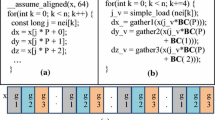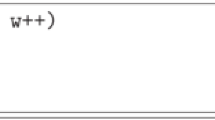Abstract
The first vector supercomputers appeared on the market in the early to mid seventies. Yet, because of the lag in developing supporting software, it is only recently that vectorizing compilers powerful enough to effectively utilize vector hardware have been developed.
Since parallel programming is a much more complex task than vectorization, we expect the challenge of producing adequate programming support to be much greater. In the ParaScope project, we will be exploring the leverage to be gained through an integrated collection of tools in which each tool depends on the others for important information. For example, the editor will depend on the interprocedural analyzer, which itself depends on the results of editing other modules. The debugger uses dependence information to assist in the location of potential problems. The user interface permits abstract displays of the data-flow information within a program.
We believe that it is essential to have this sort of cooperation to provide adequate support for programming on the evolving class of highly parallel machines.
Preview
Unable to display preview. Download preview PDF.
Similar content being viewed by others
5. References
J.R. Allen, “Dependence analysis for subscripted variables and its application to program transformations,” Ph.D. dissertation, Department of Mathematical Sciences, Rice University, Houston, Texas, April, 1983.
J.R. Allen, D. Baumgartner, K. Kennedy, and A. Porterfield, “PTOOL: a semiautomatic parallel programming assistant”, Proc. 1986 International Conference on Parallel Processing, IEEE Computer Society Press, Washington, D.C., 1986.
J.R. Allen, D. Callahan and K. Kennedy, “Automatic decomposition of scientific programs for parallel execution,” Conf. Record, 14th POPL, January, 1987.
J.R. Allen and K. Kennedy, “PFC: a program to convert FORTRAN to parallel form,” Supercomputers: Design and Applications, K. Hwang, ed., IEEE Computer Society Press, Silver Spring, MD, 1984, 186–203.
J.R. Allen and K. Kennedy, “A parallel programming environment,” IEEE Software 2(4), July 1985.
J.R. Allen and K. Kennedy, “Vector register allocation”, Technical Report 86–45, Rice University, Department of Computer Science, December, 1986.
D. Callahan, K.D. Cooper, K. Kennedy, and L. Torczon, “Interprocedural constant propagation”, Proc. SIGPLAN '86 Symposium on Compiler Construction, SIGPLAN Notices, 21(7), July, 1986.
D. Callahan, “A global approach to the detection of parallelism”, Ph.D. Thesis, Department of Computer Science, Rice University, February, 1987.
" S. Carmody et al., “A hypertext editing system for the /360”, Pertinent Concepts in Computer Graphics, M. Faiman and J. Nievergelt (eds.), Univ. of Illinois Press, 1969, 291–330..
M. Carroll and B.G. Ryder, “An incremental algorithm for software analysis”, Proceedings of the ACM SIGSOFT/SIGPLAN Software Engineering Symposium on Practical Software Development Environments, SIGPLAN Notices 22(1), January, 1987.
B.B. Chase and R.T. Hood, “Selective interpretation as a technique for debugging computationally intensive programs”, Proc. SIGPLAN '87 Symposium on Interpreters and Interpretive Techniques, June, 1987.
K.D. Cooper, “Interprocedural Data Flow Analysis in a Programming Environment,” Ph.D. Dissertation, Department of Mathematical Sciences, Rice University, May 1983.
K.D. Cooper, “Analyzing aliases of reference formal parameters” Conf. Record, 12th POPL, January, 1985.
K.D. Cooper and K. Kennedy, “Efficient Computation of Flow Insensitive Interprocedural Summary Information,” Proc. SIGPLAN '84 Symposium on Compiler Construction, SIGPLAN Notices 19(6), June 1984.
K.D. Cooper, K. Kennedy, and L. Torczon, “Optimization of compiled code in the ℝn programming environment”, Proc. of the 19th Annual Hawaii International Conference on System Sciences, 1986.
K.D. Cooper, K. Kennedy, and L. Torczon, “Interprocedural Optimization: Eliminating Unnecessary Recompilation”, Proc. SIGPLAN '86 Symposium on Compiler Construction, SIGPLAN Notices, 21(7), July 1986.
K.D. Cooper, K. Kennedy, and L. Torczon, “The impact of interprocedural analysis and optimization in the ℝn programming environment”, ACM TOPLAS 8(4), October, 1986.
K.D. Cooper, K. Kennedy, L. Torczon, A. Weingarten, and M. Wolcott, “Editing and compiling whole programs”, Proc. of the Second SIGPLAN/SIGSOFT Symposium on Practical Software Development Environments, SIGPLAN Notices 22(1), January, 1987.
R. Cytron, “On the implications of parallel languages for compilers”, Technical Report RC 11723, IBM T.J. Watson Research Center, Yorktown Heights, N.Y., 1986.
V. Donzeau-Gouge, G. Kahn, B. Lang, and B. Melese, “Document structure and modularity in Mentor”, Proc. SIGSOFT/SIGPLAN Symposium on Practical Software Development Environments, 1984, 141–148.
W.M. Gentleman and H. Hoeksma, “Hardware assisted high level debugging”, Proc. SIGSOFT/SIGPLAN Symposium on High Level Debugging, SIGPLAN Notices 18(8), August, 1983.
R.T. Hood and K. Kennedy, “A Programming Environment for FORTRAN”, Proc. of the 18th Annual Hawaii International Conference on System Sciences, 1985.
D.J. Kuck, R.H. Kuhn, B. Leasure, D.A. Padua, and M. Wolfe, “Compiler transformation of dependence graphs,” Conf. Record, 8th POPL, January, 1981.
D.J. Kuck, R.H. Kuhn, B. Leasure, and M. Wolfe, “The structure of an advanced vectorizer for pipelined processors,” Proc. IEEE Computer Society Fourth International Computer Software and Applications Conf., IEEE, October 1980.
A. Kay and A. Goldberg, “Personal dynamic media”, IEEE Computer, 10(3), 1977.
K. Kennedy, “Automatic translation of FORTRAN programs to vector form,” Rice Technical Report 476-029-4, Rice University, October 1980.
D.E. Knuth, “Literate programming”, Computer Journal, 10(3), 1977, 31–41.
D.J. Kuck, The Structure of Computers and Computations, Vol. 1, Wiley, New York, NY, 1978.
M. Moriconi and D.F. Hare, “PegaSys: a system for graphical explanation of program designs”, Proc. SIGPLAN '85 Symposium on Language Issues in Programming Environments, June 1985, 148–160.
T.H. Nelson, Dream Machines. Published by the author, 1974.
G. Raeder, “A survey of current graphical programming techniques”, IEEE Computer, 18(8), 1985, 11–25.
S.P. Reiss, “PECAN: program development systems that support multiple views”, Proc. Seventh Int'l Conf. Software Engineering, March 1984, 324–333.
T. Reps, “Optimal-time incremental semantic analysis for syntax-directed editors” Conf. Record, 9th POPL, January, 1982.
B.G. Ryder, “Incremental Data Flow Analysis”, Conf. Record, 10th POPL, January, 1983.
R.G. Scarborough and H.G. Kolsky, “A vectorizing FORTRAN compiler,” IBM J. Research and Development 30(2), March, 1986.
L. Torczon, “Compilation dependences in an ambitious optimizing compiler,” Ph.D. Dissertation, Department of Computer Science, Rice University, Houston, Texas, May, 1985.
R. Triolet, F. Irigoin, and P. Feautrier, “Direct parallelization of call statements”, Proc. SIGPLAN '86 Symposium on Compiler Construction, SIGPLAN Notices 21(7), July, 1986.
S. Weyer and A. Borning, “A prototype electronic encyclopedia”, ACM Trans. Office Information Systems, 3(1), 1985, 63–88.
N. Yankelovich, N. Meyrowitz, and A. van Dam, “Reading and writing the electronic book”, IEEE Computer, 18(10), 1985, 15–29.
F.K. Zadeck, “Incremental data flow analysis in a structured program editor”, Proc. SIGPLAN '84 Symposium on Compiler Construction, SIGPLAN Notices 19(6), June, 1984.
Author information
Authors and Affiliations
Editor information
Rights and permissions
Copyright information
© 1988 Springer-Verlag Berlin Heidelberg
About this paper
Cite this paper
Callahan, D., Cooper, K.D., Hood, R.T., Kennedy, K., Torczon, L.M., Warren, S.K. (1988). Parallel programming support in ParaScope. In: Dierstein, R., Müller-Wichards, D., Wacker, HM. (eds) Parallel Computing in Science and Engineering. DFVLR-Seminar 1987. Lecture Notes in Computer Science, vol 295. Springer, Berlin, Heidelberg. https://doi.org/10.1007/3-540-18923-8_16
Download citation
DOI: https://doi.org/10.1007/3-540-18923-8_16
Published:
Publisher Name: Springer, Berlin, Heidelberg
Print ISBN: 978-3-540-18923-7
Online ISBN: 978-3-540-38848-7
eBook Packages: Springer Book Archive




